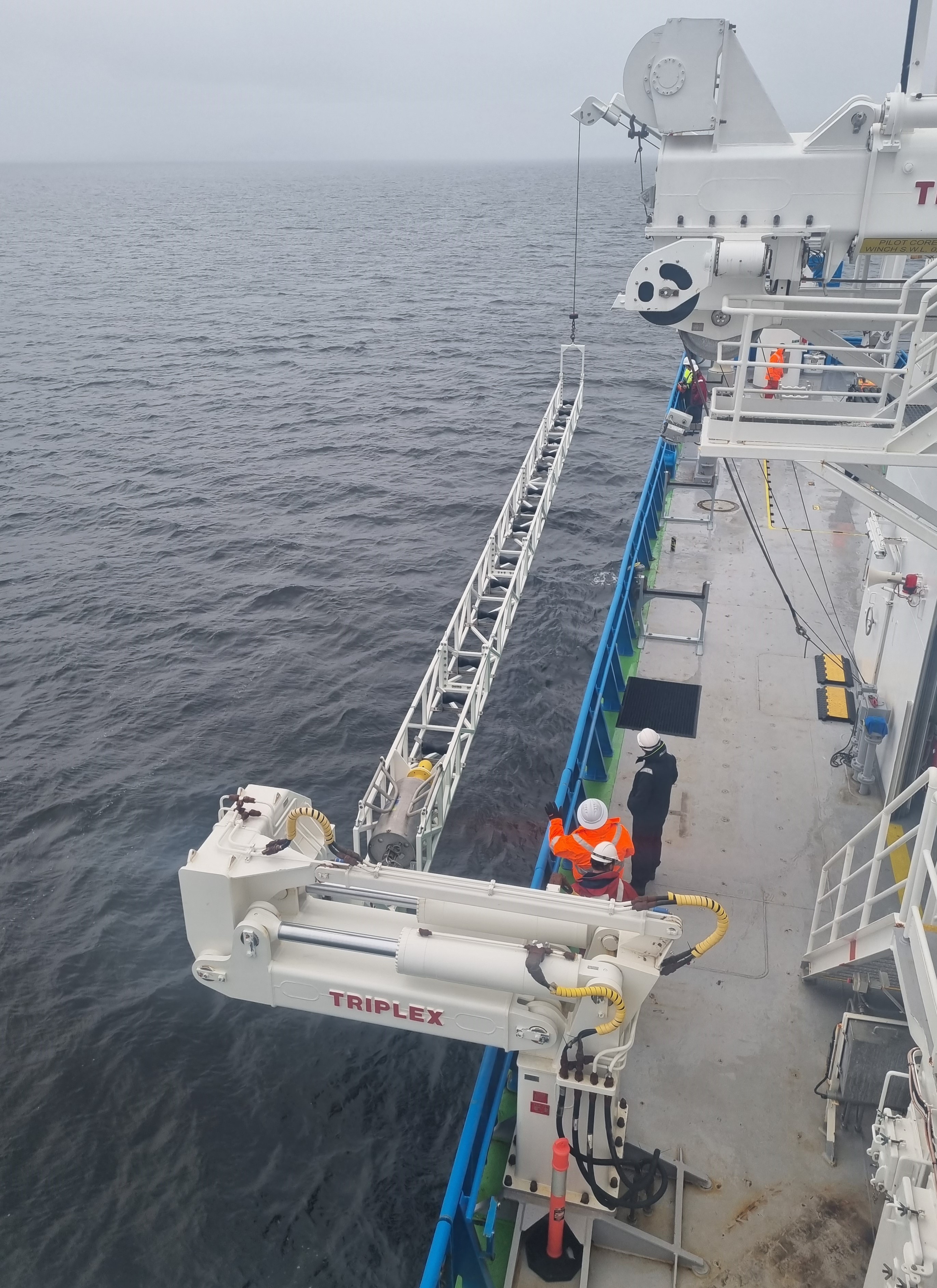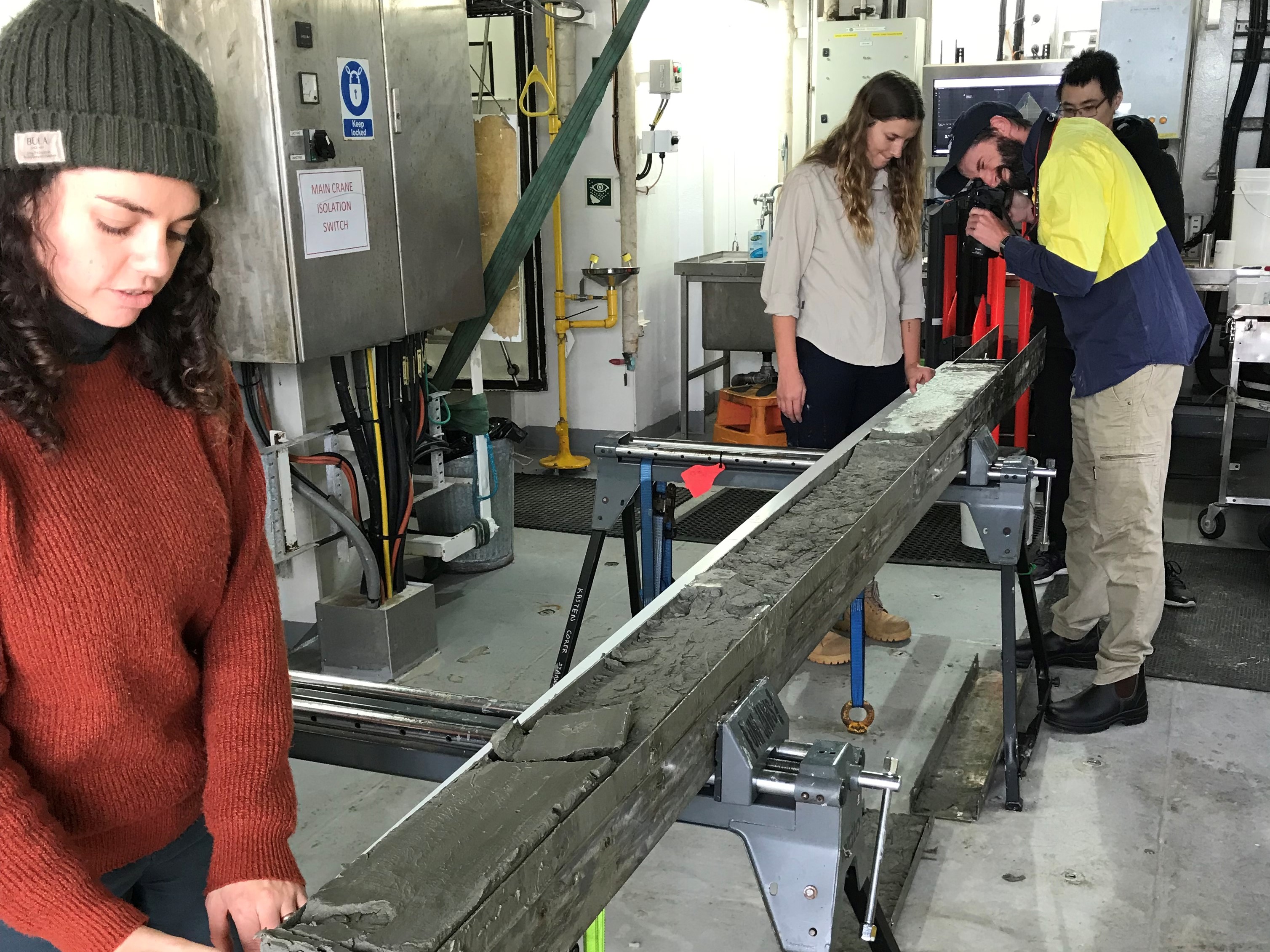What they're used for
Sediment corers can recover samples of the seafloor sediment and the top few metres of substrate. RV Investigator has a range of dedicated coring systems, including a Long Core System, Kasten core and KC Multicorer.

The vessel has the flexibility and capability to accommodate other coring systems, and units can be brought on board by researchers as required.
Long Core System
The gravity/piston coring system undertakes full ocean depth soft sediment coring, typically in unconsolidated to semi-consolidated calcareous muddy sands, silts and deep-sea oozes.
The coring system can be assembled with different length cores from 6 m to a maximum of 24 m.
Kasten core
The Kasten core uses a track and tilt system for deployment/retrieval and is suitable for full-ocean depth coring. The Kasten core is a gravity coring system with a 150 mm square core which is available in 2, 3 or 4 m lengths.
KC Multicorer
The KC multicorer is designed to sample in softer sediments at any depth. It has six tubes to collect replicate samples. Each tube is 100 mm diameter and 600 mm long.
Vibrocorer
Used to retrieve continuous, undisturbed core samples, especially in coarse sediments and shallow waters where other systems cannot be deployed.
Available through negotiation with Geoscience Australia.
Smith-McIntyre Grab
The Smith-McIntyre grab is designed to collect a core of sediment approximately 320 mm x 380 mm x 200 mm deep.
How they work
Long Core System
The coring unit is deployed from the starboard side of the vessel using a dedicated coring deployment system comprising a winch, overhead coring boom and core handling system.
The coring unit consists of the head weight, coring tube, removable inner core liner and core catcher which can be configured as a gravity corer or piston corer.
When configured as a piston corer it has an additional piston cable with release mechanism and a small trigger core. The trigger core reaches the bottom first and triggers the release of the main core which free falls to the bottom and penetrates the silt. The tube is drawn back out of the silt with core catchers preventing the silt from coming out of the coring tube.
Kasten corer

The Kasten corer is a type of gravity corer that uses a sample tube manufactured from sheet metal of square cross section. No liner is used. A cutter section fitted to the end of the sample tube has two spring-loaded flaps that close when the corer is withdrawn from the sediment. The sample tube is designed to be split to gain access to the sample.
An advantage of the Kasten corer is that cores can be opened immediately after retrieval, as one side of the core barrel can be removed giving access to the entire length of the core.
KC Multicorer
The unit is armed by lifting the entire centre section and securing the lids and lower gates open. The corer is then deployed, lowered to the sea-floor and upon 'landing' it uses 300 kg of lead weights mounted to the top of the centre section to drive the tubes into the seafloor.
When retrieval begins the lids are closed creating a suction effect to collect and retain the sample. When the tubes leave the sediment, the lower gates close retaining the sample.
Smith-McIntyre Grab
The grab is loaded on the ship by compressing the springs and setting the jaws in the open position. The grab is automatically triggered upon landing on the seafloor. When triggered, the grab is driven into the sediment by the preloaded springs and its own inertia. During retrieval, the jaws are forcibly closed by the retrieval cable, collecting a relatively undisturbed core of sediment.
The Smith-McIntyre grab is relatively reliable system, returning a good volume of sediment from suitable bottom types.
What they're used for
Sediment corers can recover samples of the seafloor sediment and the top few metres of substrate. RV Investigator has a range of dedicated coring systems, including a Long Core System, Kasten core and KC Multicorer.
The vessel has the flexibility and capability to accommodate other coring systems, and units can be brought on board by researchers as required.
Long Core System
The gravity/piston coring system undertakes full ocean depth soft sediment coring, typically in unconsolidated to semi-consolidated calcareous muddy sands, silts and deep-sea oozes.
The coring system can be assembled with different length cores from 6 m to a maximum of 24 m.
Kasten core
The Kasten core uses a track and tilt system for deployment/retrieval and is suitable for full-ocean depth coring. The Kasten core is a gravity coring system with a 150 mm square core which is available in 2, 3 or 4 m lengths.
KC Multicorer
The KC multicorer is designed to sample in softer sediments at any depth. It has six tubes to collect replicate samples. Each tube is 100 mm diameter and 600 mm long.
Vibrocorer
Used to retrieve continuous, undisturbed core samples, especially in coarse sediments and shallow waters where other systems cannot be deployed.
Available through negotiation with Geoscience Australia.
Smith-McIntyre Grab
The Smith-McIntyre grab is designed to collect a core of sediment approximately 320 mm x 380 mm x 200 mm deep.
How they work
Long Core System
The coring unit is deployed from the starboard side of the vessel using a dedicated coring deployment system comprising a winch, overhead coring boom and core handling system.
The coring unit consists of the head weight, coring tube, removable inner core liner and core catcher which can be configured as a gravity corer or piston corer.
When configured as a piston corer it has an additional piston cable with release mechanism and a small trigger core. The trigger core reaches the bottom first and triggers the release of the main core which free falls to the bottom and penetrates the silt. The tube is drawn back out of the silt with core catchers preventing the silt from coming out of the coring tube.
Kasten corer
The Kasten corer is a type of gravity corer that uses a sample tube manufactured from sheet metal of square cross section. No liner is used. A cutter section fitted to the end of the sample tube has two spring-loaded flaps that close when the corer is withdrawn from the sediment. The sample tube is designed to be split to gain access to the sample.
An advantage of the Kasten corer is that cores can be opened immediately after retrieval, as one side of the core barrel can be removed giving access to the entire length of the core.
KC Multicorer
The unit is armed by lifting the entire centre section and securing the lids and lower gates open. The corer is then deployed, lowered to the sea-floor and upon 'landing' it uses 300 kg of lead weights mounted to the top of the centre section to drive the tubes into the seafloor.
When retrieval begins the lids are closed creating a suction effect to collect and retain the sample. When the tubes leave the sediment, the lower gates close retaining the sample.
Smith-McIntyre Grab
The grab is loaded on the ship by compressing the springs and setting the jaws in the open position. The grab is automatically triggered upon landing on the seafloor. When triggered, the grab is driven into the sediment by the preloaded springs and its own inertia. During retrieval, the jaws are forcibly closed by the retrieval cable, collecting a relatively undisturbed core of sediment.
The Smith-McIntyre grab is relatively reliable system, returning a good volume of sediment from suitable bottom types.
